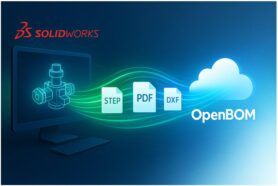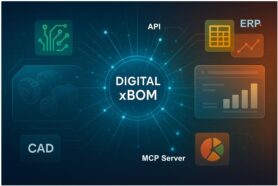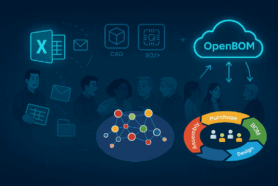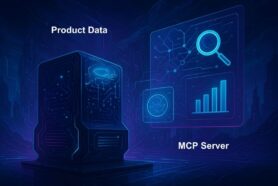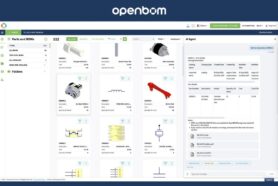
At OpenBOM, we talk to manufacturing companies of all sizes – startups, mid-sized innovators, and established enterprises, and most of them are asking the same question:
How do we choose the right PDM or PLM system?
Here’s what we always emphasize: PLM is not a cookie-cutter solution.
Even for small and mid-sized companies, selecting a PLM system requires a thoughtful approach. It’s not just about features or vendor logos. It’s about understanding the specific problems you’re trying to solve, aligning your product development workflows, and setting your organization up for sustainable growth.
That’s why, when companies come to OpenBOM, our first goal isn’t to sell—it’s to help. We offer advisory conversations, explore their current workflows, and help define clear business outcomes. Sometimes that includes trial consulting; often it leads to a better understanding of their real needs. Only then do we move toward crafting the right PLM implementation plan—at the right scope, for the right stage of the company.
In 2025, this approach is more important than ever. The noise around AI, digital transformation, and cloud technologies is louder than ever. Even Microsoft’s Satya Nadella recently suggested that AI systems will eventually replace categories like CRM, ERP, and PLM altogether. So it’s no surprise companies are asking—should we still care about PDM or PLM? Should we stick with the top three vendors and live peacefully?
Our answer: Yes, you should care, but differently.
The PLM landscape is evolving fast. And the way you choose a system must evolve too.
What’s Changed Since 2020
The first major shift? Cloud and SaaS are now the norm.
If you’re still considering an on-premise PDM/PLM system, make sure there’s a very good reason. Regulatory and security requirements in aerospace, defense, or government sectors may still justify it. But even in those cases, modern cloud systems offer region-specific hosting, data isolation, and certifications like SOC2 Type II that meet enterprise-grade standards.
At the same time, product complexity is growing. Development speed expectations are rising. And supply chains are becoming more dynamic and global. The days of managing products through a series of spreadsheets and disconnected systems are fading—fast.
Your PLM system is no longer just a tool for engineering, but it’s the digital backbone connecting design, procurement, manufacturing, and quality.
Key Questions to Address Before You Start
1. Does This Support Your Business Strategy?
Before looking at features or pricing, clarify your business goals. Are you trying to improve engineering productivity? Reduce procurement mistakes? Enable better configuration management or supplier collaboration? PLM must be tied directly to your strategic differentiators. Let your business needs—not the tech—lead the way.
2. Are the Right People at the Table?
Too often, PLM selection is led by engineering or IT in isolation. That’s a mistake. Get early input from other stakeholders such as supply chain, quality, operations, and business leadership. The goal isn’t to run a massive committee, but to include just enough voices to ensure alignment, avoid rework, and gain internal support when implementation begins.
3. Do You Have a Roadmap, Not Just a Go-Live Date?
In today’s environment, multi-year, waterfall-style PLM implementations are dead. But that doesn’t mean you shouldn’t plan. Think in phases. Identify what can be solved quickly and what needs deeper transformation. Build flexibility into the roadmap, allow for course corrections, and treat PLM as an evolving capability, not a one-time IT project.
4. Have You Tried It Using Your Data?
A real trial, using your actual data, is essential in 2025. Relying on vendor demos or polished videos doesn’t give you the full picture. Get hands-on. Ask vendors to import your parts or BOMs, try the CAD integrations, and run workflows. There is no substitute for firsthand experience.
5. Are You Working with People Who Know PLM?
PLM remains complex—even if the interface looks simple. Work with partners or vendors who understand the nuances of engineering change, configuration control, versioning, and product structure. Choose a partner you can trust – one that will stick with you, not just for the deal, but for the journey.
Your 2025 PDM/PLM Evaluation Checklist
After many experiences with our prospects and customers, here is a practical reference as you evaluate options:
✅ Trial with your data and workflows
✅ Flexible data model (supporting both structured and unstructured processes)
✅ CAD and ERP integrations that actually work
✅ Open APIs, import/export support, and industry-standard formats
✅ Cloud-native architecture with enterprise-level security
✅ Visible product roadmap and track record of frequent updates
✅ Transparent documentation, community, and support channels
Do you think we missed something? Talk to us – we are interested in learning more.
Red Flags and Vendor Tricks to Watch For
Learn from someone else’s mistakes. Here is a list of common pitfalls:
🚩 No trial available
If a vendor won’t let you try the system with your data—walk away.
🚩 No public documentation or community
In 2025, transparency is essential. If you can’t find real information online, it’s a problem.
🚩 Hiding true implementation costs behind low entry pricing and OOTB promise
It is dangerous to buy an idea of OOTB (out of the box system) that some vendors still sell. But it is too good to be true to believe that you “click on the button and it is over”. Dig for answers.
🚩 Outdated architecture masked with modern user interface and marketing presentations
A slick powerpoint or demo doesn’t mean the core architecture is modern. Vendors sell 1990s technologies to innovate in 2025.. It won’t work. Ask technical questions. Dig deeper.
Why Architecture, Data Models, and Openness Matter More Than Ever
Let’s talk about the elephant in the room: AI.
AI won’t replace PLM, but PLM will determine how well your AI works.
Why? Because the foundation of AI is data, and your PLM system is a key source of that data.
You need a platform that doesn’t just store product data, it organizes it, links it, and makes it usable. That means:
- A modern, extensible data model
- The ability to link objects into a digital thread
- Support for graph-based navigation and analysis
- APIs that allow your team to integrate and automate
- Real-time access to product information across departments
In other words: openness, structure, and accessibility. These aren’t buzzwords. They’re requirements to support what you need to deliver products on time, with the right quality and predictable cost. These are things to support your product development process, to help your team to be more efficient, agile, and stay connected.
Conclusion: PDM/PLM in the Age of Speed and Intelligence
Product development is moving faster. Teams are more distributed. Supply chains are more complex. And AI is just beginning to reshape how decisions are made.
Choosing a PLM or PDM system in 2025 isn’t about checking boxes; it’s about preparing your organization for speed, agility, and data-driven decision-making.
Forget the “big logos.” Focus on what actually fits your business. Try the system before you decide to use it.
Choose a system that grows with you.
Focus on openness and how you can grow.
Choose a partner who will guide you and not just sell to you.
And above all, choose a foundation that’s open, structured, and ready for the future.
REGISTER FOR FREE and check how OpenBOM can help you.
Best, Oleg
Join our newsletter to receive a weekly portion of news, articles, and tips about OpenBOM and our community.


